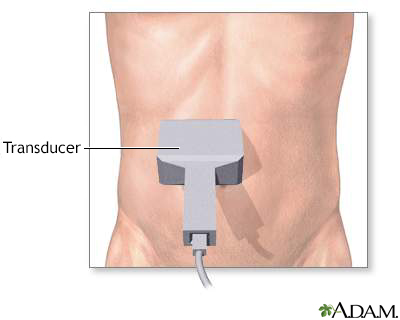Abdominal ultrasound
Ultrasound - abdomen; Abdominal sonogram; Right upper quadrant sonogram
Abdominal ultrasound is a type of imaging test. It is used to look at organs in the abdomen, including the liver, gallbladder, pancreas, and kidneys. The blood vessels that lead to some of these organs, such as the inferior vena cava and aorta, can also be examined with ultrasound.
Images





How the Test is Performed
An ultrasound machine makes images of organs and structures inside the body. The machine sends out high-frequency sound waves that reflect off body structures. A computer receives these waves and uses them to create a picture. Unlike with x-rays or CT scans, this test does not expose you to ionizing radiation.
You will be lying down for the procedure. A clear, water-based conducting gel is applied to the skin over the abdomen. This helps with the transmission of the sound waves. A handheld probe called a transducer is then moved over the abdomen.
You may need to change position so that the health care provider can look at different areas. You may also need to hold your breath for short periods during the exam.
Most of the time, the test takes less than 30 minutes.
How to Prepare for the Test
How you will prepare for the test depends on the problem. You will likely be asked not to eat or drink for several hours before the exam. Your health care provider will go over what you need to do.
How the Test will Feel
There is little discomfort. The conducting gel may feel a little cold and wet. The sonographer may press the probe against your abdomen.
Why the Test is Performed
You may have this test to:
- Find the cause of abdominal pain
- Find the cause of kidney infections
- Diagnose or monitor tumors and cancers
- Diagnose or treat ascites
- Learn why there is swelling of an abdominal organ
- Look for damage after an injury
- Look for stones in the gallbladder or kidney
- Look for the cause of abnormal blood tests such as liver function tests or kidney tests
- Look for the cause of a fever
The reason for the test will depend on your symptoms.
Normal Results
The organs examined appear normal.
What Abnormal Results Mean
The meaning of abnormal results depends on the organ being examined and the type of problem. Talk to your provider if you have any questions or concerns.
An abdominal ultrasound can indicate conditions such as:
- Abdominal aortic aneurysm
- Abscess
- Appendicitis
- Cholecystitis
- Gallstones
- Hydronephrosis
- Kidney stones
- Pancreatitis (inflammation in pancreas)
- Spleen enlargement (splenomegaly)
- Portal hypertension
- Liver tumors
- Obstruction of bile ducts
- Cirrhosis
Risks
There is no known risk. You are not exposed to ionizing radiation.
Related Information
UltrasoundX-ray
Gallstones
Kidney stones
Chronic cholecystitis
Hydronephrosis of one kidney
Splenomegaly
References
Carucci LR. Diagnostic imaging procedures in gastroenterology. In: Goldman L, Cooney KA, eds. Goldman-Cecil Medicine. 27th ed. Philadelphia, PA: Elsevier; 2024:chap 119.
Chen L. Abdominal ultrasound imaging: anatomy, physics, instrumentation, and technique. In: Sahani DV, Samir AE, eds. Abdominal Imaging. 2nd ed. Philadelphia, PA: Elsevier; 2017:chap 3.
Nickels LC, Duran-Gehring P. Emergency ultrasound. In: Walls RM, ed. Rosen's Emergency Medicine: Concepts and Clinical Practice. 10th ed. Philadelphia, PA: Elsevier; 2023:chap e3.
Wilson SR, Medellin A. The gastrointestinal tract. In: Rumack CM, Levine D, eds. Diagnostic Ultrasound. 6th ed. Philadelphia, PA: Elsevier; 2024:chap 8.
BACK TO TOPReview Date: 7/15/2024
Reviewed By: Jason Levy, MD, FSIR, Northside Radiology Associates, Atlanta, GA. Also reviewed by David C. Dugdale, MD, Medical Director, Brenda Conaway, Editorial Director, and the A.D.A.M. Editorial team.

Health Content Provider
06/01/2025
|
A.D.A.M., Inc. is accredited by URAC, for Health Content Provider (www.urac.org). URAC's accreditation program is an independent audit to verify that A.D.A.M. follows rigorous standards of quality and accountability. A.D.A.M. is among the first to achieve this important distinction for online health information and services. Learn more about A.D.A.M.'s editorial policy, editorial process and privacy policy. A.D.A.M. is also a founding member of Hi-Ethics. This site complied with the HONcode standard for trustworthy health information from 1995 to 2022, after which HON (Health On the Net, a not-for-profit organization that promoted transparent and reliable health information online) was discontinued. |
The information provided herein should not be used during any medical emergency or for the diagnosis or treatment of any medical condition. A licensed medical professional should be consulted for diagnosis and treatment of any and all medical conditions. Links to other sites are provided for information only -- they do not constitute endorsements of those other sites. © 1997- 2025 A.D.A.M., a business unit of Ebix, Inc. Any duplication or distribution of the information contained herein is strictly prohibited.
